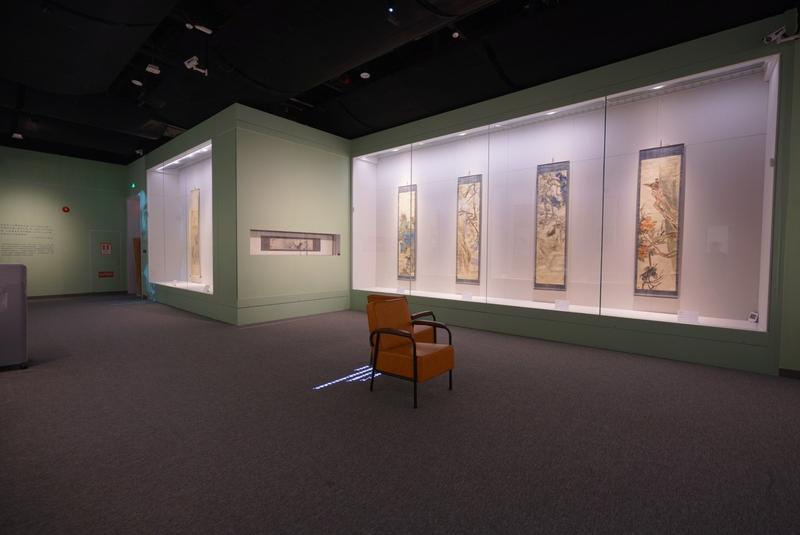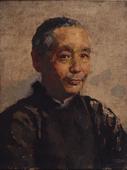A Beijing exhibition offers a closer look at the legacy of painter Ren Bonian that artist Xu Beihong further developed, Lin Qi reports.
 The exhibition in Beijing shows 50 of Ren's paintings, which were once in the possession of Xu. (PHOTO PROVIDED TO CHINA DAILY)
The exhibition in Beijing shows 50 of Ren's paintings, which were once in the possession of Xu. (PHOTO PROVIDED TO CHINA DAILY)
Pre-eminent artist Xu Beihong is known for his modern paintings of historical themes and pieces that vividly depict horses and lions as symbols of the national spirit.
He is also credited with establishing a higher education system for fine arts in China.
Xu's discernment as an avid art collector is less known to the public. He spent lavishly to build a collection of over 1,200 paintings dating from the Tang Dynasty (618-907) to the first half of the 20th century.
When he returned home after a busy day's work, Xu would relax in an armchair in his study while appreciating one of his favorite collections hung on the wall-a set of eight classical Chinese flower-and-bird ink paintings created by 19th-century artist Ren Bonian.
Xu viewed the vivid body of work as an example of Ren reaching a peak in his art during his 50s. The works especially reflect Ren's reputation as a master of color. Xu once said Ren's "ability to arrange colors was better than any other artist of his time".
 A portrait of Ren Bonian painted by Xu Beihong is one of the highlighted works on display at the exhibition From Ren Bonian to Xu Beihong. (PHOTO PROVIDED TO CHINA DAILY)
A portrait of Ren Bonian painted by Xu Beihong is one of the highlighted works on display at the exhibition From Ren Bonian to Xu Beihong. (PHOTO PROVIDED TO CHINA DAILY)
Now, the public can savor the same appreciation that Xu enjoyed when viewing Ren's works at the ongoing exhibition, From Ren Bonian to Xu Beihong, at the Xu Beihong Memorial Hall in Beijing.
A chair is placed in front of the eight paintings, providing a perspective similar to Xu's when he savored the works by Ren, who he viewed as an idol throughout his life.
The exhibition shows more than 50 of Ren's paintings once owned by Xu that are now in the collection of the Xu Beihong Memorial Hall.
Zhang Limeng, the exhibition's co-curator, says Xu accumulated a systematic collection of Ren's art, and several works are available for public viewing for the first time, including the eight flower-and-bird paintings.
She says the exhibition offers a rare chance to enter Xu's mind to understand why he had called Ren "a star of his time".
Ren, who's regarded as a leader of the Shanghai school of painting, reformed traditional Chinese ink art by injecting it with a modern spirit.
Ren's works retain the elegance and tranquillity that generations of scholar-painters have embraced throughout centuries.
 A flower-and-bird ink painting by Ren. (PHOTO PROVIDED TO CHINA DAILY)
A flower-and-bird ink painting by Ren. (PHOTO PROVIDED TO CHINA DAILY)
Ren adopted the figurative technique of oil painting and favored depicting ordinary subjects.
His works were also popular among common people, rather than just among a limited group of social elites.
Xu was won over by Ren's spirit of renovation, as well as the lyrical, romantic feelings that define his works.
Ren died in 1895, the year Xu was born.
"Xu viewed himself as a committed heir to Ren's spirit to modernize Chinese art," Zhang says.
Xu once said, "Ren Bonian was the star (artist) of his generation. He was not a scholar (who stuck to the rigid rules of art). He was a poet."
Xu also said what Ren painted was "not the physical appearance but the mentality of the times and the people".
The exhibition that runs through Feb 28 also compares paintings by Ren and Xu that depict similar subjects.
For instance, both portrayed Zhong Kui, a deity who vanquishes evil beings in Chinese mythology.
 Zhong Kui, a painting by Ren Bonian in the collection of the Xu Beihong Memorial Hall. (PHOTO PROVIDED TO CHINA DAILY)
Zhong Kui, a painting by Ren Bonian in the collection of the Xu Beihong Memorial Hall. (PHOTO PROVIDED TO CHINA DAILY)
Xu produced paintings with the same themes to conduct a spiritual dialogue with Ren.
He left brief comments on Ren's works, such as, "What a marvelous piece of art", "I've dreamed about it for months", and, "The happiness of acquiring this work makes me jump."
Xu Ji, a co-curator of the exhibition, says Xu Beihong often talked about Ren with guests at home and showed them his collection of Ren's art. He also passionately introduced Ren's talent and pioneering spirit to Europeans.
Xu Beihong had studied at Ecole nationale superieure des beauxarts, the top fine-arts school in Paris, in the 1920s.
In May 1933, he curated an exhibition in the French capital, displaying paintings by prominent Chinese artists, including Ren and master painter Qi Baishi.
Xu Ji says Xu Beihong was "not only a connoisseur but also a cultural ambassador", who was devoted to bringing great Chinese art, such as Ren's paintings, to the world.
Contact the writer at linqi@chinadaily.com.cn


